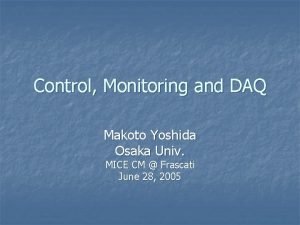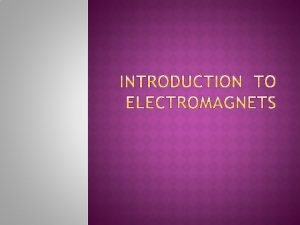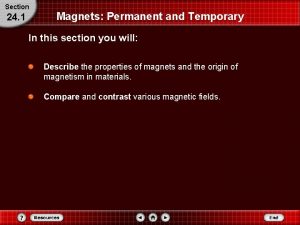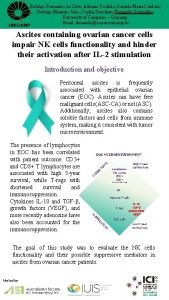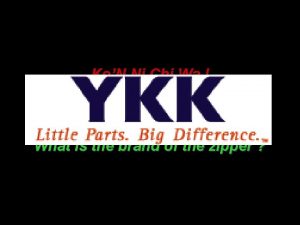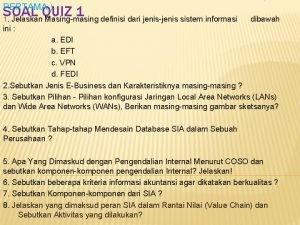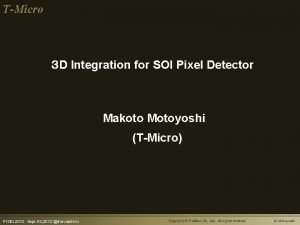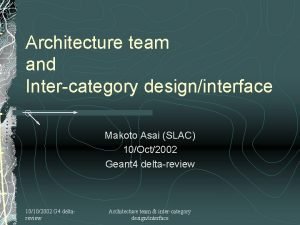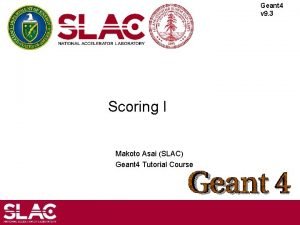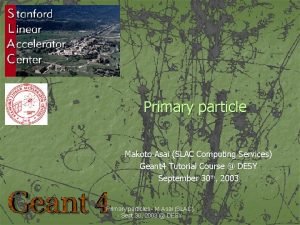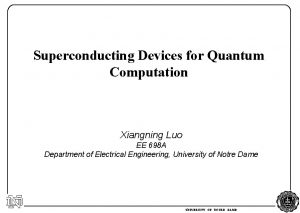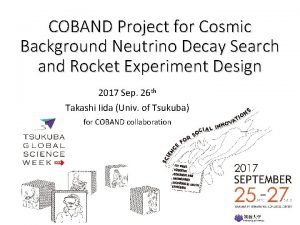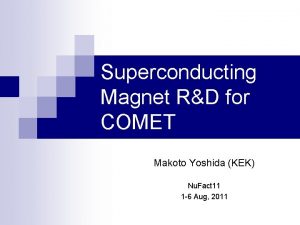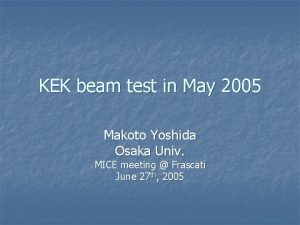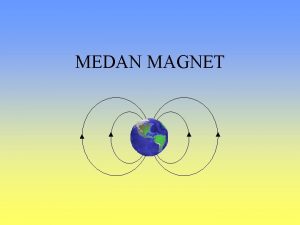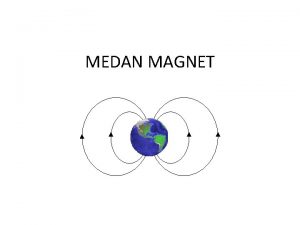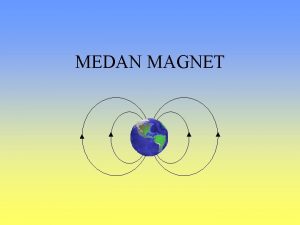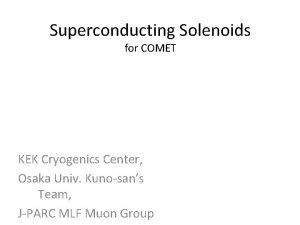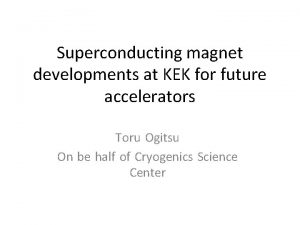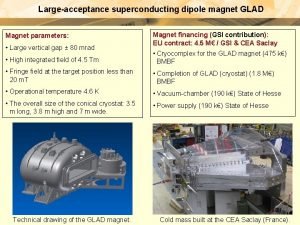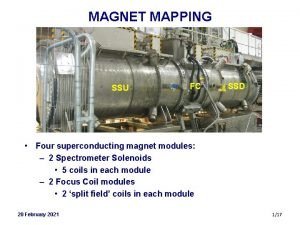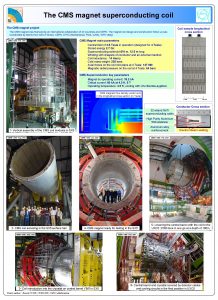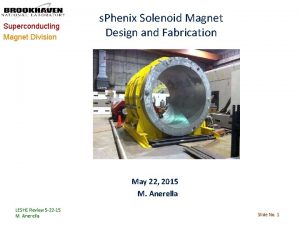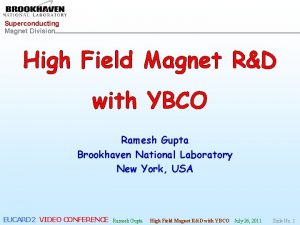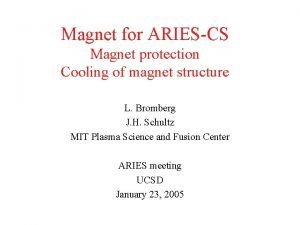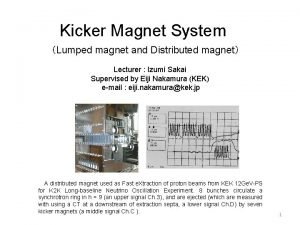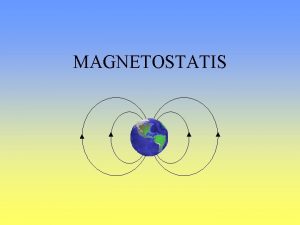Superconducting Magnet RD for COMET Makoto Yoshida KEK












![Low Temperature Irradiation Facility n n [2] M. Okada et al. , NIM A Low Temperature Irradiation Facility n n [2] M. Okada et al. , NIM A](https://slidetodoc.com/presentation_image_h2/ed2bdff8c842891beeacbcff7ce5b1f1/image-13.jpg)





- Slides: 18

Superconducting Magnet R&D for COMET Makoto Yoshida (KEK) Nu. Fact 11 1 -6 Aug, 2011

Issues in Superconducting Magnet R&D n n n Solenoid capture scheme is proposed in Neutrino Factory and intense muon (m-) source for mu-e conversion experiments, COMET at J-PARC and Mu 2 e at FNAL. Higher magnetic field is needed for better collection efficiency of pions. Superconducting magnets will provide 5 T on the target in COMET/Mu 2 e, 20 T in NF Magnet components are irradiated by severe radiation from the embedded target. Radiation issues should be considered in a magnet design. Investigation of irradiation effects on magnet materials has been initiated in 2010 with reactor neutrons

COMET@J-PARC n Searching for muonelectron conversion ¨ n n n J-PARC E 21 8 Ge. Vx 7 micro. A pulse protons from MR Aims at 1018 negative muons for 1021 protons Superconducting solenoid magnets from end to end; ¨ ¨ Pion capture Muon Transfer Spectrometer Detector Spectrometer Solenoid Detector Solenoid radiation shield pion production target Muon Transport Solenoid Pion Capture Solenoid proton b eam COMET Superconducting Magnet System

Al-stabilized superconductor n Nb. Ti Rutherford cable with aluminum stabilizer ¨ n Less nuclear heating than with Cu stabilized cable Doped, cold-worked pure aluminum ¨ Good residual resistance n ¨ RRR~500 (r 0=0. 05 n. Wm@4 K) Good yield strength n 85 MPa@4 K COMET design value n Size: 4. 7 x 15 mm n Offset yield point of Al@4 K: >85 MPa n RRR@0 T: >500 n Al/Cu/SC: 7. 3/0. 9/1 n 14 SC strands: 1. 15 mm dia.

proton COMET Magnet Design beam Cryostat-1 LHe Transfer Tube outside Iron Yoke The magnet system is separated in 3 parts: Cryostat-1: CS+Upstream. TS Cryostat-2: Downstream. TS Cryostat-3: ST+SS+DS LHe Control Dewar target station Concrete Cryostat-2 Purpose of separation: • At concrete wall • Different radiation control level • Movable Cryostat-2 for install / maintainance • Vac. separation window / antip absorber at mid. of TS • Beam monitors • At stopping target • inject electron beam into ST • Muon beam monitor experimental hall Cryostat-3

Load Line of CS, MS 4. 2 K Pion Capture Solenoid 5 K 6 K 7 K 6. 2 K LHe Transfer from TOP Warm bore for Rad. Shield supports 45 cm thick W Shield sliding rail outer vessel connection pillow seal to connect inner duct guide pin for rad. shield

Capture Solenoid of COMET 0. 7 W 1. 0 W 2. 0 W 7. 9 W proton beam 8 Ge. Vx 7 micro. A 1. 4 W 0. 9 W n Maximum heat deposit ¨ n Maximum dose ¨ n 10 m. W/kg 0. 07 MGy/1021 p Neutron flux (n/cm 2/proton) Neutrons penetrates thick 45 cm tungsten shield surrounding the target ¨ ¨ 1 x 1021 n/m 2/1021 p fast neutrons 6 x 1020 n/m 2/1021 p ( >0. 1 Me. V) Neutron fluence for experimental life-time (~1021 p) approaches a level of ITER magnets (ITER requirement: <1022 n/m 2) What’s the effects on magnet properties?

Radiation hard magnet material n Insulator, resin ¨ BT-resin, Cyanate ester ¨ Polyimide/Glass composite n Thermal insulator ¨ Al-coated n Support structure ¨ GFRP, n polyimide film; Less outgas Titanium rod Superconductor ¨ Nb. Ti, Nb 3 Sn would be OK up to 1022 n/m 2

Problematic components n Stabilizer ¨ ¨ n Thermal conductor ¨ ¨ ¨ n Aluminum alloy Copper Pure aluminum Copper Aluminum alloy n Fast-neutron irradiation induces defects in metal. n Defects could be accumulated at Low temperature, and causes degradation of electrical/thermal conductivity n Thermo sensor ¨ No experience at 1021 n/m 2 n Problems in ¨ ¨ Quench protection, Stability Cooling COMET CS LHC Project Report 209 100 K 150 K

Irradiation effects on Al, Cu in literature n pure Al (RRR=2000) ¨ Fast neutron 2 x 1022 n/m 2 Induces ri=3. 8 n. W. m [1] ¨ Perfect recovery by annealing at RT n Recovery after irradiation 2 x 1022 n/m 2 (E>0. 1 Me. V) Aluminum Copper pure Cu ¨ ri=1. 2 n. W. m [1] ¨ 10% damage remains after annealing at RT [1] J. A. Horak and T. H. Blewitt, J. Nucl. Materials, Vol. 49 (1973) p 161

ATLAS CS Indirect Cooling of Capture Solenoid n n n Possible problem with Helium bath cooling of Capture Solenoid, due to Tritium production by 3 He(n, p)3 H Propose conduction cooling to reduce irradiation of LHe Remove nuclear heating (max. 20 W) by pure aluminum strip in between coil layers Thermal conduction can be degraded by neutron irradiation Temperature gradient in coil 0. 5 mm thick, l=4000 W/m-K (RRR=2000) DT=0. 12 K ¨ If irradiation makes l=400 W/m-K DT=1. 2 K ¨ n NIMA 584, p 53 (2008) Taking into account margin for irradiation damage, thick aluminum will be used ¨ 2 mm, l=400 W/m-K DT=0. 3 K COMET Heat Removal Heat Load

Irradiation test with reactor neutron Fast neutrons can degrade electrical/thermal conduction of Al, Cu n Cold-worked Al-stabilizer and CERNOX sensor was irradiated by reactor neutrons n Irradiation and measurement must be performed in low temperature to reproduce magnet operation situation n
![Low Temperature Irradiation Facility n n 2 M Okada et al NIM A Low Temperature Irradiation Facility n n [2] M. Okada et al. , NIM A](https://slidetodoc.com/presentation_image_h2/ed2bdff8c842891beeacbcff7ce5b1f1/image-13.jpg)
Low Temperature Irradiation Facility n n [2] M. Okada et al. , NIM A 463 (2001) pp 213 -219 Kyoto Univ. Research Reactor Institute 5 MW max. thermal power [2] n n Cryostat close to reactor core Sample cool down by He gas loop ¨ n 10 K – 20 K Fast neutron flux ¨ >0. 1 Me. V) 1. 4 x 1015 n/m 2/s@1 MW 0. 1 Me. V KUR-TR 287 (1987)

reactor Cryogenics

Irradiation sample n Aluminum stabilizer sample from the superconductor by wire electrical discharge machining in KEK ¨ n n Keep defects by cold-work Size: 1 mmx 70 mm Voltage taps with 45 mm spacing 4 wire resistance measurement by nano-voltmeter CERNOX CX-1050 -SD close to sample temperature (also irradiated) Irradiation sample • 5 N pure aluminum + Cu, Mg with 10 % cold work • 1. 35 m. W @RT, 3 m. W @10 K Wire EDM

Result n n n Fast neutron exposure at 12 K-15 K Resistance was measured in situ. Resistance increased in proportional to neutron fluence in the range of 1019 -1020 n/m 2 ¨ n Observed ri = 0. 056 n. W. m for 2. 3 x 1020 n/m 2 (>0. 1 Me. V) ¨ n No threshold at low neutron fluence Good agreement with pure aluminum results (cf. [1]) In COMET life time, resistivity of stabilizer will increase by a factor of 4 for neutron fluence of 6 x 1020 n/m 2 Seasonal warmup would be necessary M. Yoshida et al. , ICMC 2011

Recovery by annealing at RT n n Perfect recovery is observed Temperature drift due to CERNOX sensor degradation?

Summary n n n Solenoid capture scheme is employed in NF/MC, mu-e conversion experiments Conceptual design of coil support, cryostat and cryogenics was carried out for COMET Radiation issues are most important for the feasibility ¨ ¨ ¨ n Indirect cooling Radiation hard organic materials Irradiation effects on electrical and thermal properties Active R&D on irradiation effect is underway First tests successfully done in 2010 Nov. -2011 Feb. Degradation of electric resistivity of Al-Cu. Mg was observed from ~1020 n/m 2. ¨ Full recovery by thermal cycle to room temperature was also confirmed. ¨ Will investigate different additives, copper, pure aluminum for thermal conduction. ¨ ¨
 Makoto yoshida
Makoto yoshida Kék alapon sárga kereszt zászló
Kék alapon sárga kereszt zászló Permanent and temporary magnet
Permanent and temporary magnet Cara membuat magnet permanen
Cara membuat magnet permanen What happens when you break a magnet in half
What happens when you break a magnet in half Marla yoshida
Marla yoshida Ruriko yoshida
Ruriko yoshida Adriana yoshida
Adriana yoshida Kon ni chi wa
Kon ni chi wa Soal uts sistem informasi akuntansi
Soal uts sistem informasi akuntansi Makoto pixel
Makoto pixel Intercategory
Intercategory Define makoto
Define makoto Makoto pipeline
Makoto pipeline Makoto asai
Makoto asai Phsyics
Phsyics Superconducting devices in quantum optics
Superconducting devices in quantum optics Coband
Coband Superconducting
Superconducting
